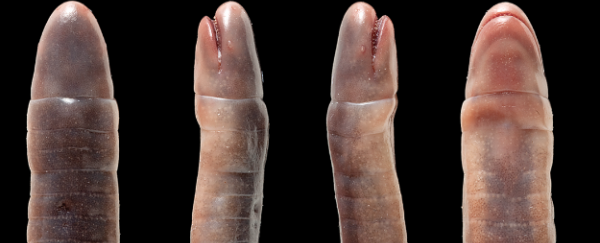Found in Central and South America, Subsaharan Africa, India, South-east Asia, and the Seychelles, caecilians are amphibious, worm-like, burrowing creatures that can grow up to 1.5 metres in length. They live mostly in tropical soils but a few aquatic and semi-aquatic species can be found in freshwater systems around the world. Their mating sessions can last for an exhausting three hours.
Almost all species of caecilian spend their lives in underground burrows, which means their natural behaviour can be very difficult to study. This makes videos like the one above all the more special.
In the 1990s, Mark Wilkinson from the Department of Zoology at the London Natural History Museum in the UK and Ron Nussbaum from the University of Michigan in the US discovered specialised baby teeth in hatchlings of the South American caecilian, Siphonops annulatus. Perhaps these babies were using their strange teeth to feed on skin secretions from their mum, they suggested, but due to the difficulty of studying them, they couldn't prove it.
More than a decade later, Wilkinson and his colleague Alexander Kupfer, also from the London Museum of Natural History, observed the young of East African species, Boulengerula taitanus, feed on their mother's skin. Described in a 2006 edition of Nature, this was the first recorded instance of this behaviour, which the pair called 'maternal dermatophagy'.
In 2008, Kupfer and Wilkinson also observed skin-feeding in the species S. annulatus, describing it in the journal Biology Letters:
"Feeding behaviour is quite frenetic with the young frequently tearing pieces of skin by spinning along their long axes and sometimes struggling over the same piece of skin. The mother remains calm during this activity. When the mother has been peeled, the young continue to search for and eat fragments of skin on the substrate. Feeding bouts are short: just seven minutes for the only complete bout observed and interspersed with long periods of quiescence. Skin feeding was seen twice in one family group separated by approximately 64 hours."
Then, just last year, Wilkinson teamed up with biologist Emma Sherratt from the London Natural History Museum to discover a new species of skin-feeding caecilian in French Guiana. Named Microcaecilia dermatophaga, the species was observed in a special burrow-mimicking lab environment as the live young hatched from their eggs.
Reporting in the open-access journal PLoS One, Sherratt and Wilkinson describe how the newly hatched, barely mobile young would start peeling off and eating their mum's outer layer of skin. This didn't seem to bother the mother though - it appeared that she had grown a special type of skin that could be easily and harmlessly shed from her body. It wasn't clear how often this behaviour took place, but after about a month, the young were old and fat enough to leave the nest on their own. They were some of the only scientists in the world to have witnessed such behaviour.
So gross, but so highly effective. Caecilians make great mums. Check out the fascinating footage above of this skin-feeding behaviour.
